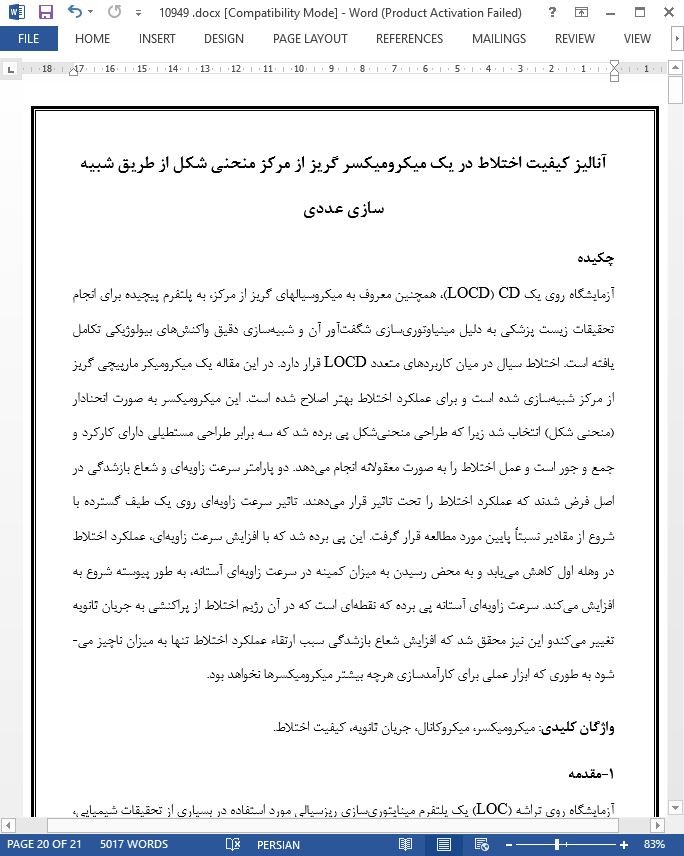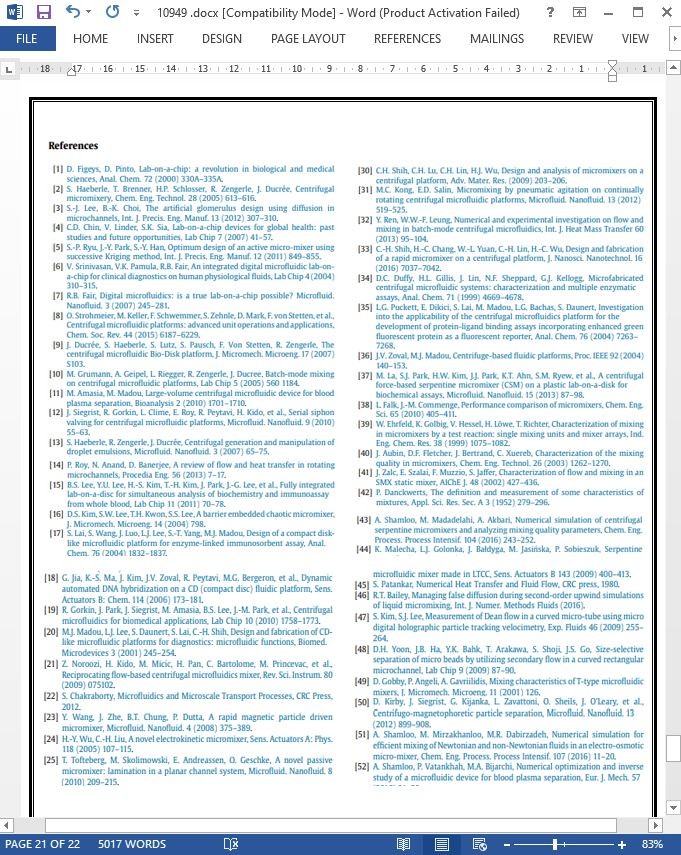
آنالیز کیفیت اختلاط در یک میکرومیکسر گریز از مرکز منحنی شکل از طریق شبیه سازی عددی
چکیده
آزمایشگاه روی یک CD (LOCD)، همچنین معروف به میکروسیالهای گریز از مرکز، به پلتفرم پیچیده برای انجام تحقیقات زیست پزشکی به دلیل مینیاوتوری سازی شگفت آور آن و شبیه سازی دقیق واکنش های بیولوژیکی تکامل یافته است. اختلاط سیال در میان کاربردهای متعدد LOCD قرار دارد. در این مقاله یک میکرومیکر مارپیچی گریز از مرکز شبیه سازی شده است و برای عملکرد اختلاط بهتر اصلاح شده است. این میکرومیکسر به صورت انحنادار (منحنی شکل) انتخاب شد زیرا که طراحی منحنی شکل پی برده شد که سه برابر طراحی مستطیلی دارای کارکرد و جمع و جور است و عمل اختلاط را به صورت معقولانه انجام می دهد. دو پارامتر سرعت زاویه ای و شعاع بازشدگی در اصل فرض شدند که عملکرد اختلاط را تحت تاثیر قرار می دهند. تاثیر سرعت زاویه-ای روی یک طیف گسترده با شروع از مقادیر نسبتاً پایین مورد مطالعه قرار گرفت. این پی برده شد که با افزایش سرعت زاویه ای، عملکرد اختلاط در وهله اول کاهش می یابد و به محض رسیدن به میزان کمینه در سرعت زاویه-ای آستانه، به طور پیوسته شروع به افزایش می کند. سرعت زاویه ای آستانه پی برده که نقطه ای است که در آن رژیم اختلاط از پراکنشی به جریان ثانویه تغییر می کندو این نیز محقق شد که افزایش شعاع بازشدگی سبب ارتقاء عملکرد اختلاط تنها به میزان ناچیز می شود به طوری که ابزار عملی برای کارآمدسازی هرچه بیشتر میکرومیکسرها نخواهد بود.
1-مقدمه
آزمایشگاه روی تراشه (LOC) یک پلتفرم مینایتوری سازی ریزسیالی مورد استفاده در بسیاری از تحقیقات شیمیایی، زیست پزشکی و بیولوژیکی است؛ برای مثال آزمون مراقبتی در بالین بیمار (POCT) [1، 2، 3، 4، 5]. به دلیل ابعاد کوچک خود، میزان نمونه مصرفی و معرف نسبت به دیگر پلتفرمهای آزمایشگاهی معروف بسیار کم است؛ برای مثال نانولیتر در برابر میلی لیتر، سبب می شود تا LOC با در نظرگیری هزینه های مادی بسیار کارآمد باشد [6، 7]. چندین ماژول یا واحد عملیاتی می توانند روی LOC برای کاربردهای متعدد در تحقیقات بیولوژیکی همانند اختلاط، شیر تنظیمی و جداسازی بنا شوند [8]. مسئله در ارتباط با LOC این است که هر واحد عملیاتی نیازمند یک میکروپمپ مجزا، اغلب پمپهای سرنگی، به عنوان نیروی محرکه آن جهت فعالیت است. بنا به این دلیل، LOCهای چندمنظوره نسبتا کمیاب هستند از آنجایی که به کارگیری چندین میکروپمپ در یک LOC سبب پیچیدگی طراحی آن می شود و ساخت آن را سخت تر می سازد. جهت غلبه بر محدودیت چندمنظورگی، آزمایشگاه روی یک CD (LOCD) معرفی گردید.
4- نتیجه گیری
در این مقاله، یک میکرومیکسر مارپیچی گریز از مرکز همراه با تغییراتی که عملکرد اختلاط را افزایش دادند، مورد تحقیق و بررسی قرار گرفت. طراحی میکرومیکسر منحنی شکل بود از آنجایی این پی برده شد که به دلیل جریان دین قوی ناشی از انحناء، میکرومیکسر منحنی شکل کاملا بهتر از طراحی مستقیم خطی معمول عمل می کند. برای بیان کمی آن، طراحی منحنی شکل به کیفیت اختلاط 90 درصد در طول کانال رو به پایین 10 میلیمتر دست پیدا می کند در حالیکه طراحی مستقیم خطی معادل به این میزان کیفیت اختلاط در طول 30 میلیمتر دست پیدا می کند.این بدین معنی است که طراحی منحنی شکل دارای عملکرد سه برابر بهتر و سه برابر فشرده تر از نقطه نظر طراحی هندسی است. اثر سرعت زاویه ای LOCD روی عملکرد اختلاط به طور کامل مورد مطالعه قرار گرفت.
Abstract
The Lab On a CD (LOCD), also known as Centrifugal Microfluidics, has evolved into a sophisticated platform for performing biomedical assays due to its marvelous miniaturization and accurate simulation of biological reactions. Among the numerous applications of the LOCD is fluid mixing. In this paper a centrifugal, serpentine micromixer is simulated and reformed toward better mixing performance. The micromixer was chosen to be curved as a curved design was found to be thrice as functional and compact as a rectilinear design, mixing-wise. The two angular velocity and opening radius parameters were originally hypothesized to affect mixing performance. Effect of angular velocity was studied over a broad range starting from quite low values. It was gathered that with increasing angular velocity, mixing performance initially drops and upon reaching a minimum at a threshold angular velocity, begins to continuously increase. The threshold angular velocity was found to be the spot at which the mixing regime changes from diffusion to secondary flow. It was also realized that increasing the opening radius enhances mixing performance only insignificantly, such that it would not be a practical means of making micromixers more efficient.
1. Introduction
The Lab-On-A-Chip (LOC) is a microfluidic miniaturization platform used in many chemical, biological and biomedical assays; e.g. the Point Of Care Testing (POCT) (Figeys and Pinto [1], Haeberle et al. [2], Lee and Choi [3], Chin et al. [4], Ryu et al. [5]). Because of its small dimensions, the amount of the consumed sample and reagent is significantly less than other known experimental platforms; i.e. nanoliters vs. milliliters, making the LOC extremely efficient concerning material expenses (Srinivasan et al. [6], Fair [7]). Several modules or operational units could be erected on the LOC for various applications in biological assays such as mixing, valving and separation (Strohmeier et al. [8]). The problem with the LOC is that each operational unit requires a separate micropump, mostly syringe pumps, as its driving force to operate. For this reason, multifunctional LOCs are rather scarce since employing several micropumps in an LOC complexes its design, making it harder to fabricate. To overcome the limitation on multifunctionality, the Lab-On-A-CD (LOCD) was introduced.
4. Conclusion
In this paper a centrifugal, serpentine micromixer was investigated along with modifications which enhanced mixing performance. The micromixer was given a curved design since it was realized that because of a strong Dean flow induced due to the curvature, the curved micromixer functions quite superiorly to a typical, rectilinear design. To put it quantitatively, the curved design reaches 90% M.Q. within 10 mm of down-channel length, whereas the equivalent rectilinear design reaches it in 30 mm. This means the curved design is three times as functional and compact, from a geometric design perspective. The effect of angular velocity of the LOCD on mixing performance was comprehensively studied.
چکیده
1-مقدمه
2- فرمولاسیون عددی و معادلات حاکمه
2-1- هندسه اصل و طراحی
2-2- شرایط مرزی
2-3- روش عددی
3- نتایج و بحث
3-1- آنالیز حسایت شبکه
3-2- آنالیز اعتبارسنجی
3-3- اثر انحناء
3-4- تاثیر سرعت زاویه ای
3-5- اثر شعاع بازشدگی
4- نتیجه گیری
ABSTRACT
1. Introduction
2. Numerical formulation and governing equations
2.1. Geometry and design principle
2.2. Boundary conditions
2.3. Numerical method
3. Results and discussion
3.1. Grid sensitivity analysis
3.2. Validation analysis
3.3. Effect of curvature
3.4. Effect of angular velocity
3.5. Effect of opening radius
4. Conclusion
- ترجمه فارسی مقاله با فرمت ورد (word) با قابلیت ویرایش، بدون آرم سایت ای ترجمه
- ترجمه فارسی مقاله با فرمت pdf، بدون آرم سایت ای ترجمه



